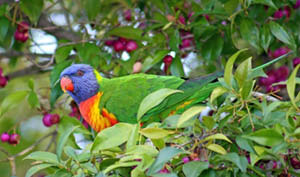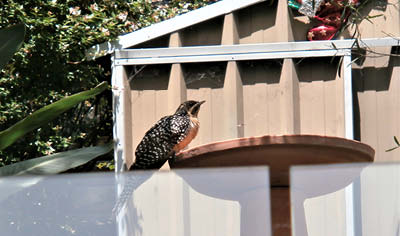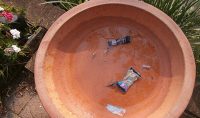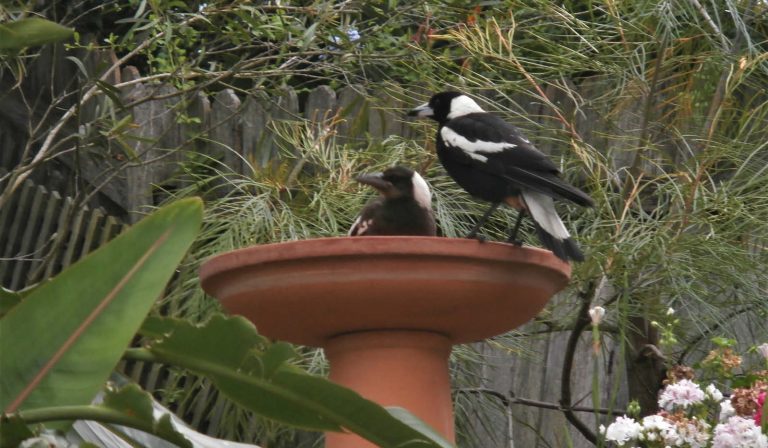JOHN McNAMEE FIGHTS A LOSING BATTLE
It used to be a haven of peace and safety. The main attraction was a $40 special item from Bunnings but for the local bird life it was as popular as Bondi beach is to a Pommy backpacker.
Over the course of a day, several pairs of lorikeets would flock to the terracotta birdbath and wallow delightedly in the shallow water screeching, flapping their wings and emerging like drowned rats to prance around the rim bobbing and weaving and chattering like excited children.
They’d land on the big jacaranda tree which sheltered the birdbath from both the sun and any lurking predators and trapeze their way down doing somersaults and tumble-turns with twists before hitting the cooling waters.
We’d be sitting in the sunroom gazing in awe at this wonderful spectacle and admiring the brilliant colours of the various species.
A family of magpies would come down later in the afternoon, mum, dad and junior (still with greyish, downy plumage on their backs) and share a communal dunking, warbling away in their inimitable manner and sharpening their beaks on the rough earthenware sides of the bowl.
They’d land first on the nearby trellis and begin the noisy ritual of feeding the insatiable fledgling amid a frenzied whirring of juvenile wings and manic squawking.

Another of our favourites were the wattle birds…we called them the “typewriter birds” because they would flit around in the water, shaking their backsides like Elvis in Jailhouse Rock and chattering their beaks in a distinct “tap-tap-tap-tap” rhythm.
Just recently, we noticed sadly, a pair of beautiful wattlies whose nest had obviously been invaded at the egg stage, flying backwards and forwards on countless missions trying to feel the voracious appetite of a fat cuckoo chick, treating it as one of their own.
But over the years we’ve also had visitations from such varied species as bulbuls, willy-wagtails honeyeaters, butcherbirds, and the entrancing fairy wrens, many of them rarely seen again.
Keeping the water at a fair level in the birdbath (particularly in our water-restricted times) and scouring it out was a full-time job but we felt privileged that these fabulous winged creatures sought safety in our modest beachside refuge.
But then all hell broke loose and the idyllic tranquillity was shattered.
First it was the ominously coloured, stiletto-beaked, beady- eyed, slick-backed black crows (corvus coronoides) whose fierce appearance is accentuated by flaring throat hackles.
They’d swoop down from aloft, perch on the fence overlooking the bath, make a few horribly mournful cawing sounds and plunge into the water almost sending the whole kit and caboodle crashing into the ground.
Now I don’t begrudge anyone a drink…just ask my mates and they’ll tell you no-one goes dry at a McNamee barbecue.
But when the quiet drink on a hot day almost becomes a revolting ritual, then that’s where I draw the line.
So when the defiant crows started bringing items of half-eaten food, mouldy old sandwiches, bread rolls, burgers , lolly papers and disgusting looking salad wraps which they’d obviously scavenged from nearby garbage bins, and dunking them in the water and leaving them there to fester, well that was it.
I’ve heard of fouling your own nest, but this was downright obscene.
Something drastic had to be done about those dastardly pests. They had obviously driven away the smaller species.

First, I tried just scaring them off with some wild man-of-the-bush whooping sounds and much flapping and whirling of the arms. Then I started banging my thongs together and shaking the branches of the nearby bottlebrush.
Didn’t work. They just stood their ground on the edge of the bath and fixed me with their satanic glare, daring me to approach closer.
I didn’t want to go too near them because I could still vividly recall as a kid down on my uncle’s farm how they’d wait till a spindly-legged little spring lamb became separated from the mother ewe and they’d swoop down and pluck the newborn’s eyes out leaving it bleeding and bleating piteously.
There was only one thing to be done. I’d have to withdraw their source of water and “decommission” the birdbath. I took the bowl off the pedestal and turned it upside down. That’d fool ‘em! Harsh I know, but I was a desperate man.
They hung around for a few days looking bewildered and then they stopped coming. So did the magpies, who actually perched up on the pedestal looking down inquisitively into the hollow stem. But I was starting to feel a bit guilty.
One day after the crows disappeared I said to the wife: “Look darl, I think I’ve outsmarted the ravens, I bet that’s the last we’ll see of them, aha!!!.”
She was giving me some strange looks so I said: “It’s not cruel is it? They’re a scourge to other bird life, good riddance, I reckon.,”
“They’re only birds darling, god’s creatures,” she replied with a sigh, “they are only following their natural instincts.”
I slunk off somewhat abashed but I hopefully refilled the bird bath and set it up under the jacaranda and waited for the return of the precious small fry.

Nothing happened for days, the beloved birdbath was like a ghost town.
Then the currawongs came.
This fearsome looking bird is also endowed with a beady eye and a menacingly sharp beak.
If we thought the crows were bad with their soggy rituals of takeaway leftovers, then the currawongs were much worse.
It was berry season and the garden soon became littered with the half-digested husks of all sorts of tree fruit, as the currawongs feasted on this plentiful seasonal harvest.
Worse was to come. Like the crows, the curras had no respect for their food or drink source and the birdbath soon became clogged up with regurgitated and blood-coloured berry seeds and other unidentified disgusting items.
After spewing up their nasty discoloured stomach contents, the curras then added insult to injury by immersing themselves in the water and defecating whatever was left in their digestive system.
No sooner had I emptied the contaminated water out, flushed it out and scoured out the bowl, than they’d come back and repeat their toxic voidings. Fair dinkum, I felt as if I was using more water than we did for household purposes. Not good.
So once again, I was reluctantly forced to take the bird bath “off line” as they say these days.
Flocks of lorikeets still keep swooping across our garden, but these days, they know not to drop in for a drink.
I haven’t decided when I’ll put the birdbath back in its place of glory. The crafty currawong and crows are still lurking around…I hear their raucous cries, and I’m sure they’re only waiting for me to lose my nerve.
The magpie family still sits up in the jacaranda glaring down accusingly at me.
But at least I proved that, even for a short time maybe, I was smarter than the average bird…or am I?





1 Comment
In our Bird families we have Crows,kookaburras,magpies,butcherbirds,lorries,pheasant,sulphur crest cockatoo,corella silvereyes,whistling ducks,wooducks,topknotpigeons.Galahs and magpie geese,and others who try and squeeze into our small birdbath and a couple of bowels.so if your not using yours please send it our way.?